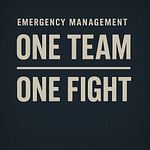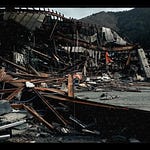I am the child of the cold war. Our movies were Red Dawn, War Games, Spies Like Us, and Stripes, just to name a few. We practiced duck and cover, and we had fallout shelters in the basements of our schools. The threat of nuclear war was always there, and the fear was real.
Since the fall of the Soviet Union, nuclear war has become a conversation only old people talked about. Russia and China became friends with the United States, and we worked together to end the talk of Mutual Assured Destruction (MAD).
At a White House Press Conference this week, Press Secretary Karine Jean-Pierre nonchalantly said, “we continue to call out Putin with what he is doing with the nuclear strikes” She then moved to other questions without a second thought.
NATO defense ministers will gather this week. One topic of discussion is the risk that Russian President Vladimir Putin might use nuclear weapons in Europe. Putin and the Russian military launched missile attacks against Ukraine's civilian population center in response to the truck bombing of the Kerch Bridge, reinforcing the notion that the Kremlin remains unpredictable.
The world is starting to forget the realities of nuclear weapons.
Since the Russian takeover of the Crimean peninsula in 2014, the region has seen an exodus of ethnic Ukrainians and Tatars and an influx of Russians, including a military buildup.
Putin perceives Crimea as closer to the core of Russian vital interests than the Kharkiv region, which was recently liberated by Ukrainian forces. If and when Ukrainian conventional military forces approach Crimea in hopes of liberating it, According to military pundits and foreign affairs experts Putin may feel more tempted to use a nuclear weapon.
In North America, the threat may not be direct. However, The potential Russian use of nuclear weapons demands at least thinking through possible responses. The American military began to study this threat shortly after Putin’s forces invaded Ukraine. Now is the time to discuss the impacts on the civilian population rather than waiting until a crisis moment.
The other consideration we need to explore is how a Russian Nuclear strike would push NATO into war. Although the current US administration has been vague on how they would react, it is likely to bring the full force of the Alliance down upon the beleaguered Russian military. This could prompt the involvement of China, Iran, and Syria into action, with support from Venezuela and Cuba.
What Are the Next Steps?
What might the menu of the next steps include? This summer New York City’s Office of Emergency Management produced a public service announcement advising residents how to survive a nuclear attack. And after some questioned the advisory's timing, The City administration defended its action. According to OEM officials, the campaign's goal is to inform the public on ways to stay safe if nuclear weapons were pointed in New York's direction.
This harkened to the Duck and Cover days of the 1950s Civil Defense Burt the Turtle campaign. I must admit that I wondered what the Adams administration knew that the rest of the United States did not. I don’t think they were wrong to produce such a PSA today.
FEMA’s Ready.gov site does have a page dedicated to a nuclear explosion, offering solid advice on what to do if you’re in the vicinity of one. This is not an archive page or old information and has been updated, and it notes the pandemic could cause some problems when finding shelter. The page suggests bringing items to protect yourself and your family from COVID-19, such as masks and hand sanitizer if you are evacuated.
As of the writing of this piece, only New York City has taken any measures to prepare its population for a nuclear strike. We are a profession that has come from Civil Defense, and I wrote a piece about “Should We Revisit Civil Defense?” I was asking if we should use programs that the CD used for community preparedness. Maybe I was on to something bigger?
Podcasts
The Todd DeVoe Show
Steps You Need To Create a Process for Crisis Management
When a natural or human-caused disaster occurs, the process of how the situation is handled sets the tone of response and recovery.
The goal of crisis/disaster management is to respond quickly and effectively to minimize damage and position your organization or jurisdiction for recovery once the crisis has passed.
A successful process is proactive. It aims to reduce the delay in response and recovery by anticipating potential problems, such as natural disasters or safety concerns. It creates procedures for how you will react if something goes wrong.
Crisis/disaster management is crucial for high-profile businesses that can be subject to serious damage to their reputation, whatever the size or scale of the crisis.
Business Continuity Today
Sharping The Saw, Why You Need to Continue to Learn
When you sharpen your mental saw, the best way to rejuvenate your dulled-down mind is not to turn it off but to give it something different to think about than what it usually grinds through at work. Not only will this fresh mental fare stimulate unused parts of your brain, but it can also give you insights and ideas that can loop back into your professional success.
Prepare Respond Recover
Why Public-Private Partnerships Are Critical
Public-Private Partnership is an agreement between a public agency and a private sector entity. Through this agreement, the skills and assets of each sector are shared in delivering a service or facility for the use of the general public. As governments seek to upgrade infrastructure and address the challenges of climate change, among other objectives, the need for private-sector involvement has grown. When considering pricing risk in a comprehensive and transparent way, governments can tap into the true expertise of private players. Brian Barnier, Head of Decision Science and Analytics, is focused on growing companies, investments, and countries, bringing practical insight to investors, boards, and management to help them bridge from strategy to execution. He accelerates improvement in business results through a "risk lens" that incorporates both growth and turnaround lessons learned across industries, professional disciplines, and countries.
What To Read
How the costs of disasters like Hurricane Ian are calculated – and why it takes so long to add them up
By Adam Rose, University of Southern California
Preliminary property damage estimates for Ian so far range from $42 billion to as much as $258 billion, with some landing in the middle.
If the higher end of the estimates proves more accurate, that alone would make Ian the costliest natural disaster in U.S. history.
However, property damage is only one aspect of disaster costs.
Another, which is often neglected, is a business interruption – the decrease in economic activity measured either in terms of lost revenue or a combination of lost wages and profits.
Business interruption begins when the disaster strikes and continues until the economy has recovered. In this case, it is likely to take several years, as happened after Katrina destroyed Louisiana, Alabama, and Mississippi in 2005.
Of course, these costs do not count lives lost or human misery, such as the number of people left without power or clean water….
Law Enforcement and the Incident Command System: Consider Cultural Bias Issues
By: Dr. Randal A. Collins, CEM
It is well known that of the public safety services, law enforcement has arguably been the service to most resist the implementation of the Incident Command System. I do believe, though, even as one of the staunchest ICS advocates, that perhaps other services might consider giving law enforcement a bit of a pass and stop unrealistic changes. Perhaps we should look at ICS and ask, “why is ICS not working for law enforcement,” instead of looking at law enforcement and asking, “why is law enforcement not utilizing ICS?”
First, let’s eliminate two basic assumptions that many people make. ICS is not perfect. While I believe that we should embrace ICS and use it as the tool it is, it was created by humans, which means it is fallible, and we should always seek to change and improve it to create a better process. It was created by firefighters for firefighters, which leads me to my second assumption. The fire service and law enforcement are not the same because they are both public safety and work closely together on emergencies. They are often lumped together within jurisdictions and our biased minds because of their commonalities…















Share this post